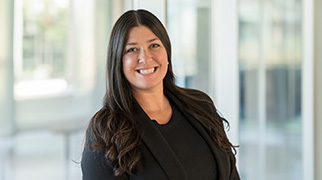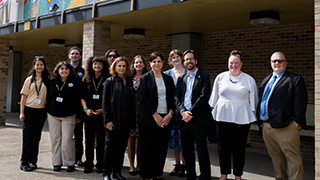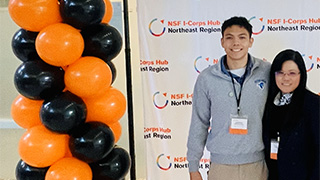Nursing Professor's Study Calls into Question Standard Caseload for School Nurses: 750 Students Per Nurse - Seton Hall University
Thursday, September 10, 2020

Beth E. Jameson, Ph.D., R.N., assistant professor in the College of Nursing
As the pandemic continues throughout the United States, the nation has turned its attention back to schools, and the many questions involved in their reopening. Obviously, there are public health concerns to be reckoned with, and school nurses, presumably, are at the forefront of that reckoning within K-12. But how many students should each school nurse be charged with, both in "normal" times and in the midst of a pandemic?
Normally, it turns out, a ratio of 750 students per each nurse is considered by many to be the standard, but that ratio was never based on research or supporting evidence. And there are problems with that ratio, even in normal times, Beth E. Jameson, Ph.D., R.N., assistant professor in the College of Nursing — along with Lori S. Anderson, Ph.D., R.N., a clinical professor at the University of Wisconsin–Madison's School of Nursing, and Patricia Endsley, M.S.N., R.N., a school nurse at Wells High School in Maine — undertook a nationwide study of 27 school nurses to determine if the use of a caseload ratio alone used to calculate workload is sufficient.
Looking at a previous survey from 2016 that identified ways of measuring workload, Jameson and her team's recent study, "Identification of workload measurement indicators for school nursing practice," sought to identify additional indicators that might be considered as significant variables in measuring the number of students that school nurses can reasonably serve.
The study determined that a number of indicators were missing from previous workload assessments and should be considered in staffing calculations moving forward. "School nursing workload is much more complex than a student-to-nurse ratio," said Jameson, citing that "appropriate staffing and funding of school health is a must in order to provide safe, quality care and ensure optimal health and academic outcomes."
Per Jameson, the number of students in the school is only part of the equation as every school is different. "Appropriate staffing is accomplished through understanding and considering the complexities of the role of the school nurse and the student care that is provided. Using a ratio of nurse to student alone is not evidence-based or appropriate," she added.
Through focus groups, it was revealed that some of the factors that the school nurses believed integral to any measurement of workload include a determination of the number of students with chronic illnesses and/or those who need medication administered; the average daily number of student visits to the health office; social determinants of student health, such as the number of students without access to healthcare or with English as a Second Language issues; characteristics of the nursing staff, such as level of experience or whether they have specialized skills; and characteristics of the school community, such as total number of students served, number of buildings served or age-level of students.
The research team's future recommendations are for "pilot testing with school nurses to determine the impact of the workload indicators. [this] would include nurses specifying the extent to which the indicator affects their daily workload and the frequency of occurrence of this indicator in their daily work." These next steps would allow researchers to get a better handle on the impact these factors have on school nurse workload and availability.
Marie Foley, Ph.D., R.N., dean for the College of Nursing, recognized the importance and timeliness of this research. "School nurses are at forefront of the care of our children. Now, more than ever, it is important that school nurses have the resources they need to keep our children safe and well," said Foley, adding, "Dr. Jameson and her colleagues work is critical to maintain the safety and well-being of the nation's school age and adolescent students and their teachers and staff."
We asked Jameson to further expand on her research and what it may mean in regard to the current pandemic.
How does your research relate to the current pandemic and with schools opening for
in-person instruction?
In this pandemic — whether schools are opening in-person, hybrid, or remotely — the
workload of the school nurse is greatly impacted. Many people may have the false impression
that if students are not in the schools, then there is no need for the school nurse.
Nothing could be further from the truth.
School nursing is a hidden system of health care in this country. For many of our nations' children, the school nurse is the safety net and fills the gap in access to healthcare. School nurses have continued to work as the school and community resource for COVID-19 information and for assisting families navigating health care in the pandemic. Who is responsible for weeding through all the myriads of documents and changing recommendations to make sure that all the required items to keep faculty, staff and students safe and healthy? What is the air filter type required for the isolation room? How big does the isolation room need to be? How many masks and what type of masks do we need for the staff who work with students and cannot maintain social distancing? Where are we going to put the isolation room? Who is developing policies and procedures? The answer to all these questions is the school nurse. The pandemic adds a tremendous burden on already thinly staffed schools with nurses being responsible for infectious disease tracking, identification, and prevention, as well as keeping track of screening data, keeping in touch with remote students, more staff training and more meetings.
To your knowledge, did school districts generally involve school nurses with the planning
for the 2020-21 school year in regard to COVID?
That is a great question, especially for areas of our country where there are no school
nurses. The most recent national survey of school nurses in the U.S. found that approximately
25 percent of school districts do not employ a school nurse1. A school nurse brings
health care and expertise to the planning and implementation of the policies. This
is anecdotal, but I have heard of nurses who had to advocate to be involved in planning.
They were not at the table when big decisions were being made. However, I have also
heard that nurses were involved in administrative meetings — some for the first time,
so it has been very positive. The big concern is the schools where there are no school
nurses.
What are the challenges facing school nurses this year?
Trying to keep a lid on the spread of the virus in the school and isolating those
who show symptoms, all while entering cold and flu season, will be difficult. Some
nurses are being asked to do contact tracing and charged with determining if there
enough resources, funding, purchasing of personal protective equipment (PPE) and evidence-based
safety measures in place.
Also, with all of the things that go into prevention, new school nurses are particularly overwhelmed. In light of this, many districts are hiring additional nursing staff. Additional challenges include keeping up with immunization requirements and having to offer immunization clinics due to many students not be kept up to date as parents kept their children home due to COVID fears and did not visit the doctors' office for regular well-child appointments.
In your opinion, should children be going back to school this fall?
My personal opinion is that they should not. We do not know the long-lasting effects
of COVID-19 on children; some do get very sick. We also are seeing how children might
be important factor in the spread of the coronavirus. Children have larger viral loads
in their upper respiratory tracts than adults.
The question of whether students should return to school may also depend on where they live, what is degree of community transmission, and are the schools prepared to implement social distancing and other CDC recommendations. Attention to policies and funding of school nurses has always been at the mercy of local school budgets. With wide discretion on how schools fund school health services, employment of a school nurse in some districts is not considered a must-have resource.
- Willgerodt, M. A., Brock, D. M., & Maughan, E. D. (2018). Public school nursing practice in the United States. Journal of School Nursing, 34(3), 232-244. https://doi.org/10.1177/1059840517752456
Categories: Health and Medicine





